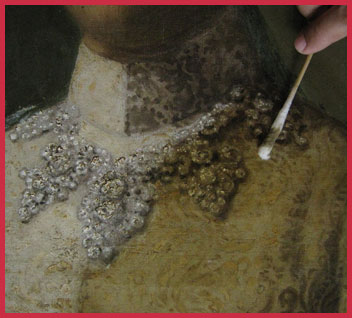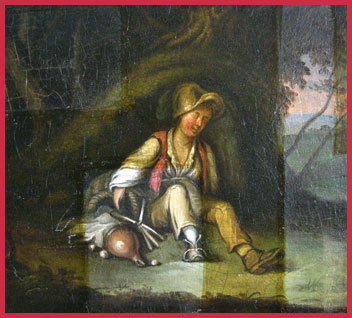



What is conservation and restoration?
Conservation is to preserve and increase the life expectancy of an actively deteriorating artwork or a collection of artworks. It deals with deteriorating artworks to improve their conditions and maintaining their stability for a prolonged period whereas restoration means to renovate and return an artifact to its original condition.
The job of the conservator and restorer is always to preserve and maintain the art object as close to the original state as possible for as long as possible with the aid of experience, skill and scientific knowledge. The results of good restoration often seem miraculous, especially as the owner of a painting may never have seen it in anything like its original state.
Care of paintings
Paintings and their frames are made of many different materials. Together they form a complex structure that is easily damaged if knocked. The materials are also sensitive to and can be damaged by the surrounding environment extremes and changes in humidity and heat, as well as by light dust dirt and pollution.
How well a painting survives over the years depends on keeping it in a good environment and on sensible handling, storage and display.
Damages
Paintings can be damaged in many ways. The canvas might be torn or punctured, or may have split at the edges. The painting might have developed sagging, bulges or dents. If done on panel rather than canvas, you may see splits, warps and cracks in the wood; the wood will also be susceptible to insect damage. Even if the support material appears sound, you may find that the image itself has areas of cracked, loose or flaking paint, lost paint, or fading. It may have yellow/brown varnish, dirt and dust, whitening, mould or mildew on the surface. The frame may be in poor condition which places the painting at risk of physical damage.
Many of the problems identified above are caused (or made worse) by poor environmental conditions. Most of the materials in a painting respond to changes in relative humidity and temperature by expanding and contracting. If the relative humidity keeps on changing then the painting will expand and contract repeatedly; the structure will become stressed and begin to fall apart. Paint layers may crack, canvas may split, wood may split and paint flake off.
In a museum the environment can be controlled but this is not usually an option in the home. In the home, a painting can suffer quite easily from high and low humidity.
Too much light can fade certain colours and will speed up the darkening of varnish.
- If you think your painting has a problem or you want to find out more about its condition, contact a paintings conservator.
- Save any pieces that have fallen off, however small. Keep them safely as they can always be put back on.
- Avoid hanging paintings near heat, light , on damp walls
Care of Paper artworks
Works of art on paper appear in almost every private or public collection. Paper is made of cellulose in the form of finely broken down plant fibers. In its purest form, cellulose is extremely durable, but preparation methods, additives such as acids, unpurified wood pulp can cause the paper to become weak and dark over time. Materials used by artists may also be unstable. Pigments can fade, inks can corrode the paper, pastels and charcoal get smudged, and thick paint like oils and gouache can flake.
Damages
Works of art on paper such as prints, drawings and watercolours can be damaged by light, extreme or fluctuating temperature and relative humidity, pollution, pests, and poor handling, storage and mounting.
- Watercolour paintings or ink drawings can be faded by light. The original colours can often be found at the edges which are covered from light by a mount. Exposure to light damages the structure of the paper itself. It is best to keep works of art on paper in a cool, stable environment which will help in slow deterioration and reduce the damages by insects and mould.
- Temperature affects the speed of the chemical reactions leading to brittleness and darkening of the paper.
- Deterioration of glue size in the ground.
- Aging paint film tends to lose its elasticity and becomes more susceptible to flaking, cracking and cupping.
- Water damage, fire damage, or physical damage from a blow can also cause the paint film to flake.
- The brown spots called ‘foxing’ stains are caused by bacteria or mould which generally grows on acidic paper when the humidity is high, or when there are metallic particles in the paper as a result of the papermaking process.
- Insect damage and mold growth are indications of an uncontrolled environment in which humidity and temperature are high.
- Backing boards contains unpurified wood pulp may turn paper brown and brittle. Yellow or brown stains on paper can be due to the glue or adhesive tapes used to fix the picture into a mount. Self-adhesive tapes are particularly damaging because the adhesive creeps into the paper and is then extremely difficult to remove.
- Good quality archival and museum quality mounting and framing is one of the most effective methods of preserving and caring for works of art on paper.
Temperature and Relative Humidity Conditions
- Because warm or moist conditions accelerate deterioration. High temperature and RH also encourage mold growth and insect activity.
- Climatic fluctuations cause expansion and contraction, which can lead to structural damage in paper, weaken the media, and cause distortions
- Temperature can usually be controlled by heating and air conditioning, but more expensive equipment may be necessary to keep the RH constant all year.
- During periods of high humidity, use fans to circulate air and help discourage mold growth. Above all, do not store works of art in basements, attics or in dark areas.
Basics for Art collectors and Art lovers
- Never lean the front or back surface of a stretched canvas on a pointed or sharp object. This will leave a dent that will disfigure your work. If you must lean it against something, lean it on the wood of its stretcher bars so that nothing presses against the canvas.
- Prolonged exposure to direct sunlight will fade the colors in your painting. Take care to avoid direct sunlight. Dust your artwork with a soft and a dry brush.
- Varnish is a protective surface, which will not only enhance the image, but will keep the surface intact and paint layer safe from direct attack.
- If you must transport the work, lay a flat piece of cardboard, mat board or similar firm material over the front and back surfaces, and then wrap it in bubble wrap or Styrofoam wrap. Try not to keep it wrapped up for too long as to avoid moisture buildup, which might cause damage to the work.
- Never expose your paintings to extreme heat, extreme cold, or to extreme humidity.
- If something goes wrong with the artwork, don’t do it yourself! Bring it to someone who knows what to do. Never, ever destroy or throw away an original work of art!!!
Art and artifacts have the power to teach, inspire, enlighten, and evoke emotion. Without their protection and preservation, we will lose our inheritance.

